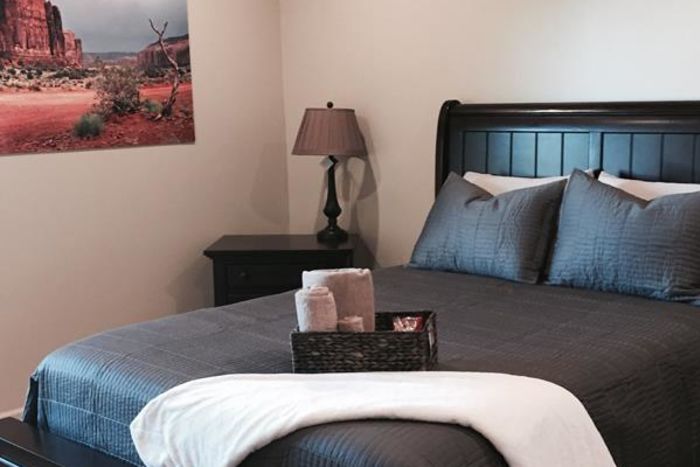It’s common for CEOs to be portrayed as energetic, in control, and collected. But executives and people in high-level positions face demanding challenges and workplace-related stress that can take a toll on their mental health. With so much going on, you may not notice signs of addiction or addictive behavior until it negatively impacts your career or life at home.
People in high-level positions may have specific queries about going to rehab, like laptop use during treatment or privacy concerns. We’re here to answer those questions and more about attending rehab as an executive.
Understanding Addiction Among Executives
Is Addiction Common Among Executives?
Factors leading to the development of alcohol or substance use disorders are never cut and dry. However, several combining elements may make high achievers more susceptible to addiction.
As people become increasingly open about mental health issues,1 more CEOs who’ve faced addiction2 are sharing their stories. And as it turns out, hundreds of CEOs, high-level professionals, celebrities, athletes, and artists share the same struggle.
Neurological factors, trauma, and stress are some of the reasons why high achievers may turn to substance use.
Neurological factors: Addiction researcher and neuroscience professor David Linden, Ph.D. explains in his book The Compass of Pleasure: How Our Brains Make Fatty Foods, Orgasm, Exercise, Marijuana, Generosity, Vodka, Learning, and Gambling Feel So Good that the same mechanisms (dopamine receptors) encouraging us to achieve our goals can also push us towards substance use.
Trauma and anxiety: Outlined in Ending Addiction for Good authored by addiction researchers Richard Taite and Constance Scharff, Ph.D., high achievers who turn to substance abuse have likely experienced early life trauma that shapes the way they behave. This trauma can fuel their drive to succeed, but they may also turn to substances as a coping mechanism.
Stress: As an executive, you’re probably already aware of the daily stress you face. Entire teams of people rely on you, there’s pressure to maintain a certain public image and to keep performing at high levels. This leads to overwhelm and oftentimes, burnout. It’s common for executives to develop unhealthy habits, like substance or alcohol misuse,3 to cope with their stress.
What Are the Characteristics of Addictive Behavior?
First, it’s important to note that by “characteristics,” we mean characteristic behaviors associated with alcohol or substance abuse, not personality traits. The common notion of the “addictive personality” is a myth.4 The Global Journal of Addiction & Rehabilitation Medicine reports that: “Research finds no universal character traits that are common to all addicted people.”
The same study notes that some practitioners consider specific personality traits as potential warning signs that someone could develop an addiction, but that’s all they are: signals. They don’t guarantee that an individual will become addicted. According to David Linden, PhD, a neuroscience professor at Johns Hopkins’ School of Medicine, some of these predictors of addiction include the drive for success,5 obsession and risk-taking—all common among high-achievers.
While you may or may not exhibit those personality traits, certain telltale behaviors indicate alcohol or substance abuse:
- Engaging in risky behavior while under the influence
- Continuing to use substances despite their negative consequences
- Stashing or hiding your substance use from others
- Persistent cravings and spending a lot of time thinking about using substances
- Consuming more substances than before to feel the same effects
- Experiencing withdrawal symptoms when you try to quit
Modern research shows that addiction falls on a sliding spectrum,6 challenging previous notions that addiction is “all or nothing.” According to the Diagnostic and Statistical Manual of Mental Disorders (DSM-5), people who exhibit 2 to 3 of the behaviors above are considered to have a “mild” substance use disorder, while those who exhibit up to 6 or more symptoms have a “severe” substance use disorder.
How Do I Know if I Need Rehab?
There’s a stigma around what people facing addiction look like, or what their lives are like. If your life appears to others to be going well, you might not realize that you have a substance use problem. You may even deny it because you don’t “fit that stereotype.” But prolonged substance abuse can have permanent, detrimental effects on the mind and body, which is why it’s better to seek treatment sooner rather than later.
You might want to consider looking into addiction treatment if you notice these common signs of alcohol or substance abuse, as outlined in the DSM-5:
- A strong urge to use substances
- Persistent unsuccessful attempts at cutting down or controlling your substance use
- Taking substances in larger quantities or for longer than you intended to
- Continuing to use substances even if it negatively impacts your work or relationships
- Spending a lot of time trying to get substances, use, or recover from the effects of substance use
- Continued substance use, even if it negatively impacts your life
How Long Do I Need to Go to Rehab For?
This depends on your substance use background, including the severity, length, and type of substance used. While the length of different residential rehab programs varies, they’re generally 30, 60, or 90 days long. Some programs may run even longer and last up to 180 days.
You can find out your recommended length of stay when you call a rehab center. Usually, an admissions specialist will take you through a series of questions called an “initial assessment” to determine what length of stay is appropriate for you. While some people need to be in rehab for shorter periods than others, a significant amount of research shows that longer residential rehab stays correlate to better outcomes.7
Can You Go to Rehab for Anxiety?
Yes, you can. Many residential rehabs treat anxiety and other mental health issues, even if they don’t co-occur with a substance use disorder.
If you’re an executive who suffers from anxiety, you’re not alone. According to the Anxiety & Depression Society of America, anxiety is the most common mental illness in the United States,8 affecting over 40 million adults each year. However, job-related stress can be more detrimental to the health of CEOs and high-level decision-makers. A study released by the U.S. National Bureau of Economic Research found that CEOs of large companies are prone to higher mortality rates9 and age visibly faster due to work-related stress. If you find yourself struggling with anxiety, several different anxiety treatment options are available, including virtual therapy, outpatient programs, and inpatient care.
Can I Still Run a Business With an Addiction?
In short, not for long and not without negative effects on your physical and mental health, and potentially your relationships.
High achievers are under major pressure to perform. If you feel the need to work more and to carry on a certain image, even in the face of troubling mental health or addiction issues, others share your struggle. A Harvard-reviewed study revealed that up to 60% of people struggling with mental health issues have never spoken up about it at work.10
What’s more, many people who suffer from substance use disorder but are high-functioning might avoid seeking help because they can still perform at work, to a certain degree. You may convince yourself that you’re doing fine because your life isn’t in shambles.
However, experts claim that signs of substance abuse in the workplace are just the tip of the iceberg.
According to an article in the Canadian Medical Association Journal, Chair of the Physician Health Program Committee at Saskatchewan Medical Association Dr. Petter Butt argues that the myth of the high-functioning addict11 should be debunked. “It means we’re purely looking at function through the window of their workplace … [addiction] takes a terrible toll on people’s families and on children in particular,” he states. Over time, one’s work will also begin to suffer.
Butt adds, “It’s possible to treat the ‘functioning addict’ before the facade crumbles.”
What are the Signs of High-Functioning Alcoholism?
High-level executives face a lot of pressure to appear collected and together. However, life may look very different behind closed doors. The U.S. Substance Abuse and Mental Health Services Administration (SAMHSA) revealed that people in management have some of the highest rates of alcohol use12 compared to other professions.
You may not realize the implications of your drinking because you’re high-functioning, you don’t fit the stereotype of an “alcoholic,” or haven’t “hit rock bottom” yet. This makes it difficult for many people to spot the signs of high-functioning alcoholism. Sometimes, it takes an event like an accident or a health scare before you realize that your drinking has become a problem.
If you’re concerned about your drinking, here are some telling signs of alcohol use disorder as listed in the DSM-5:
- The inability to stop drinking
- Drinking more, or for longer than you intended to
- Feeling increased irritability, mood dips, or anxiety as a result of drinking
- Experiencing withdrawal symptoms such as insomnia, sweating, or shaky hands when you discontinue drinking
Rehab for Executives
How to Get Addiction Help as an Executive
Executives, celebrities, politicians and other high-achievers often have so much going on that they’re not aware of signs of substance abuse. This can be especially true if you’re in a profession that normalizes drinking or illicit drug use.13 If you notice worrying signs of abuse, you might hesitate to begin your recovery journey because of work requirements. However, prolonged alcohol or substance abuse can have serious health consequences.14 Stepping away from work to seek treatment may seem difficult in the short-run, but it will certainly be beneficial to your health and can even help with long-term productivity.
There are several addiction treatment options for executives. These centers often have facilities like a business center or a flexible technology policy, and luxurious amenities so you can recover in comfort and greater privacy.
Once you’ve recognized the need for help and want to start looking for treatment centers, you can take steps to find a program that fits you:
- Receive a clinical assessment by a mental health professional.
- Consider your recommended treatment options.
- Find a treatment provider that is ideally reputable, trustworthy, accredited, qualified, and with licensed professionals.
- Weigh your options and consider factors such as treatment approach, location, amenities, and more.
- Call the treatment provider and schedule a tour, if you can.
For a more in-depth take on finding the right addiction treatment option for you, see our Ultimate Guide to Choosing a Treatment Provider.
Are There Rehab Programs for Executives?
Several private, inpatient luxury rehabs offer executive programs. These programs often include features that take into consideration the needs of high achievers:
- Greater discretion
- The ability to use technology during rehab
upscale settings - Amenities that help promote comfort and healing
- High-quality clinical care
- Highly-personalized treatment
- Tailored services like a private chef or personal trainer
…and more.
Oftentimes, the medical and clinical staff at inpatient executive rehabs have been treating clientele like you for years and understand your unique needs.
Where Do CEOs Go to Rehab?
Because of their unique lifestyle, executives are more likely to consider rehabs based on location, privacy, amenities, and comfort, and whether or not the rehab has an executive program.
Those who want to protect their privacy without giving up on comfort may opt for a luxury destination rehab. Some popular locations for executives include California and Florida in the U.S., and Switzerland.
California: Rehabs in California are known to attract A-list clientele. It consistently ranks among the top U.S. states with the best health care, and this translates to addiction treatment. Many centers have long been established and have earned a reputation. And California is no stranger to luxury: Malibu was one of the first places to popularize the concept of high-end, resort-style rehabs. Because it’s such a sought-after rehab destination, it’s home to some of the top addiction treatment centers in the world.
Florida: Florida rehabs have something for everyone, from executives to people who seek gender-specific addiction treatment. In addition to the various treatment options offered, rehabs in Florida have been catering to high-net-worth clientele for years. If you attend a luxury center in the sunshine state, there’s a good chance you’ll work closely with a clinical team dedicated to creating your individualized care plan.
Switzerland: For executives who want to escape the bustle of large cities or are seeking extra privacy, rehabs in Switzerland offer a special combination of confidentiality and comfort. The country is famous for its attention to quality and service. Here, you can expect to find a high concentration of luxury rehabs that offer uber-individualized care.
Of course, these aren’t the only destinations CEOs look to for rehab. Some prefer to recover surrounded by nature and will look at rehabs in Colorado. Others may want a destination that offers one-of-a-kind experiential therapies, like a safari in South Africa.
What’s a Typical Day in Rehab Like?
You’ll follow a full, recovery-focused schedule in rehab. Most days involve therapy sessions supported by activities and leisure time, and scheduled work time if you attend an executive rehab. A day at luxury rehab might look something like this:
- Wake up early to a healthy, nourishing breakfast
- Join a group therapy session
- Move your body with a fitness class or activity
- Have lunch with others in your program
- Post-lunch downtime
- Complete a 1-on-1 therapy session
- Scheduled work time
- Attend an educational or support group session
- Eat dinner, followed by a wind-down activity like music or art therapy, or individual free time
Activities and outings are often influenced by the rehab’s location. Jerry Vaccaro, President at All Points North Lodge in Vail Valley, Colorado, details some activities common to the area:
“On weekends, we have a ton of activities. Patients can snap on their snowshoes and go walking. You might even see some elk. Or, we may take you on a trip to the ski slopes. In warmer weather, activities might include fly fishing on the beautiful rivers here. We try to balance the intense nature of treatment with activities that help you decompress and think about what you just experienced.”
Can I Still Work While at Rehab?
Rehab is a protected environment that allows you to disconnect from the outside world and turn your focus inward. However, not everyone can take time off work, and that’s understandable. You can still make the most out of treatment while fitting work into your schedule.
Most executive rehab programs have a flexible technology policy so you can stay connected during certain hours and keep your office running. Some also have business centers to work from. Regardless, you’ll want to check directly with a rehab center about their technology policy to make sure it suits your needs.
For some people with a more demanding schedule, bespoke programs and single-client rehabs may fit best. For example, politicians or celebrities may need to make public appearances during their time in treatment. Single-client rehabs are usually hyper-individualized and may be more accommodating to these types of requests.
Which Rehabs Allow Laptops?
Different rehab programs have different tech usage policies. Many luxury rehabs offer an executive program, allowing professionals to stay connected with work during their time in treatment.
You can browse our list of luxury executive rehab programs to learn more about centers with flexible technology policies.
What Amenities Do Luxury Rehabs Offer?
It’s important to feel comfortable in rehab. Contrary to the belief that rehab should be punishing, being in an uncomfortable environment can negatively impact your mood and receptiveness to treatment. Luxury rehabs offer special amenities that executives and high net-worth clientele may be used to, allowing them to relax and feel at home:
- Swimming pools
- Saunas
- Fitness/wellness center
- Business center
- Outdoor lounge
- Tennis court
- Theater
- Gourmet dining
- Personal concierge
Privacy in Rehab
Can I Keep My Rehab Stay Private as a CEO?
Confidentiality concerns can be a major barrier to treatment for CEOs and people in high-profile positions. The good news is you can keep your rehab attendance private.
From single-client rehabs to centers in secluded locations, there are a variety of ways rehabs accommodate your privacy needs:
- Inpatient (residential) rehab offers distance from your community. You’re removed from your everyday environment, reducing the chances of being recognized.
- Many luxury inpatient centers are in secluded, discreet locations and aren’t even recognizable as rehabs from the outside. Some don’t list their location information publicly.
- Ultra-private luxury rehabs take in one client at a time, so your stay is completely confidential.
- Destination rehabs can offer an extra layer of privacy.
- Virtual rehab programs let you receive treatment from the comfort of your home.
On top of that, rehabs in the U.S. must adhere to clinical standards of patient confidentiality:
- The Health Insurance Portability and Accountability Act,15 or HIPAA, is a law that protects your medical records and health information. Under HIPAA, a rehab cannot share your health information without your knowledge or consent.
- 42 CFR Part 2 is a section of HIPAA that applies directly to addiction treatment programs. Under this law, a rehab center cannot disclose any information that reveals that you’ve dealt with addiction, even with other medical providers. All recovery programs must adhere to 42 CFR Part 2.
Does Rehab Go on Your Record?
In most cases, rehab attendance doesn’t go on your record. An exception would be if you had broken the law in some way, for example, if you were arrested for possession of narcotics. In these cases, the U.S. Equal Employment Opportunities Commission prohibits employers from using criminal history information16 to discriminate against you.
In all cases, HIPAA protects your medical information17 and any information that may disclose your rehab attendance.
What Are Rehab Privacy Laws?
When you attend rehab, you’re protected by certain privacy protection laws. Two important laws include HIPAA and 42 CFR Part 2.
HIPAA
The Health Insurance Portability and Accountability Act,18 or HIPAA, is a national law that prevents the disclosure of any of your medically related information without your consent or knowledge. Under HIPAA, you have the right to access and request amendments to your health records.
Healthcare providers, health plans, healthcare clearinghouses, and business associates must comply with HIPAA.
42 CFR Part 2
42 CFR Part 219 is a section under HIPAA that offers more stringent privacy protection than HIPAA and pertains directly to substance use disorder treatment. Under this law, treatment providers can’t disclose any information that suggests you’ve dealt with addiction. This is to protect you from unfair treatment in legal cases involving employment, divorce, and more.
Find Healing at an Executive Rehab Program
Many executives find it difficult to disconnect and free themselves from workplace stress. When this stress occurs in conjunction with a substance use disorder, it takes a heavy toll on your physical and mental health.
Because it can feel like you’re in charge of keeping everything running, you may be hesitant to seek addiction or mental health treatment. However, your mental and physical well-being are important. You deserve time to focus inward. Thankfully, plenty of rehab programs cater to the needs of executives. These programs ensure you can still reach the people who rely on you while you take time to heal.
Explore the world’s top luxury rehabs for executives.






























